Archer’s note
This essay will touch on all of the following:
– historical and modern horror stories
– historical depiction of mental illness, including stigmatizing patterns and language
– ritual murder and suicide
Please consider your mental state and taste before reading.
Please also note that, while this essay touches on several grim historical practices, those are not representative of either Shinto or Buddhism!
The Legend of Zelda: Breath of the Wild has a special place on my gaming shelf. It was the first open world game I truly enjoyed, and the first game I shared in-depth analysis for.
BOTW started the hobby that took on a new life when I played Dark Souls, years later. This essay was originally presented as a talk at several conventions.
All screenshots used are my own.
Breath of the Wild, like many of the other games in the Legend of Zelda series, is deeply rooted in Japanese culture. It pulls on both Shinto and Buddhist themes, as well as historical literary forms influenced by both traditions.
This essay is not intended to be an in-depth examination of BOTW’s lore, but rather to compare the tale of Calamity Ganon to one of those literary forms: the vengeful ghost story as it was told in Heian Period Japan. To that end, this essay will first examine a simplified pattern of these historical stories; then give a brief overview of several types. Once the context is laid, I will look at how Breath of the Wild fits into the haunting patterns of ancient Japan.
Bones of the Ghost Story
There are many different ghosts in Japanese mythology, and this essay does not intend to represent them all. However, an interesting pattern appears when looking at vengeful ghosts in particular:
- Something goes wrong with the victim
- A miko is called to deal with the spirit
- She tries to pacify the ghost, by appeasement or by ritual
- She may soothe it, she may exorcise it, or she may be overwhelmed
- In the latter case, call in the Priest!
- The priest, and possibly also the miko, handle the ghost by spiritual force
Exorcists, Victim, Ghost
Let’s examine the historical and folkloric roots of the cast of these tales.
The victim can be a person, an organization, or even a place. In any case, this is where the malicious efforts of the ghost will be observed. There’s a victim in every ghost story, but sometimes it is a sacred place, such as a shrine, pond or mountain; sometimes it is a household, a city, or even a country, that has fallen under the power of the angry spirit.
Wearing a white robe tucked into red hakama, the position of miko is specific to Shinto, the indigenous religion of Japan. In the modern day, miko are assistants at shrines, frequently helping to sell Shinto items, perform ceremonies, and even clean the shrine. Historically, the miko played a much larger role, as some of the most spiritually and politically powerful figures in Japan. Miko were believed to possess shamanic abilities, from predicting the future to communicating with spirits, and were the equals of Shinto priests. They were frequently traveling shamans, who might be invited to one place or another to assist with the spiritual troubles of life.
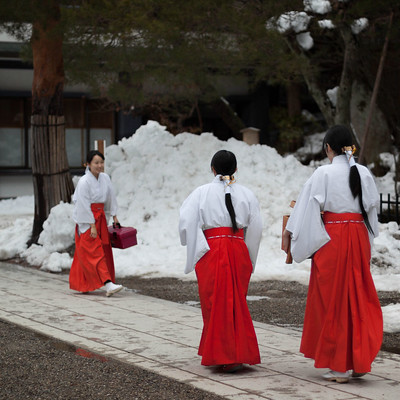
“miko” by mathias-erhart is licensed under CC BY-SA 2.0
There are many figures who might be called a priest. The one most of interest to us is a yamabushi 山伏, who is not strictly a Shinto priest (kannushi 神主). Instead, the yamabushi is something of a counterpart of the miko, though the role originated later in history. With roots in Shugendo, a syncretic fusion of Shinto, Taoism, and Buddhism, the yamabushi filled a very similar role: that of a shamanic ascetic, albeit one more likely to stay in a certain place, who could exercise spiritual power on the behalf of ordinary people.
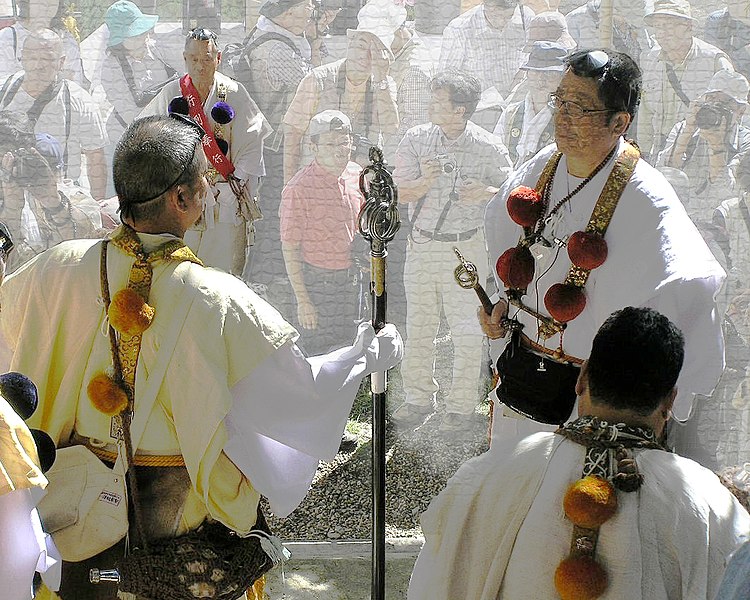
“Contemporary-Yamabushi-rm” by 南無観自在 and Flora fon Esth is licensed under CC BY-SA 4.0.
Note the pectoral ornaments the yamabushi wear.
The ghost is a more complex topic, and there’s several types that are likely to be of interest when looking for the historical patterns of ghost stories in BOTW.
For an easy entry into the deep waters surrounding Japanese ghosts, let’s examine a classically Japanese art form: Noh plays. Noh also has deep roots in Shinto, and takes place on a stage nearly identical to that for sacred dance or kagura 神楽. In this case, it is most interesting to use the patterns derived from several plays rather than discuss any single one in depth.
A Short Catalog of Ghosts
Madwoman tales
Noh dramas known as kyojo’mono, or “madwoman plays,” have women as their central figures who have, for one reason or another, become defined by their anger or grief. Their extreme mental state drives them into transformation. They become demons who spread their pain to others.
The afflicted women are immediately identifiable by their long, unkempt hair, their pale faces, and their simple white robes thrown askew by careless, impassioned movement. (This description may sound familiar to fans of Japanese horror movies; read on!)
The transformed woman is generally exorcised, if she remains alive.
Hungry Ghosts
Drawing from Buddhist conceptions of the afterlife, hungry ghosts or gaki 餓鬼 are eternally hungry and thirsty, to the point that their starved bodies cannot be satisfied by any food or drink. The Gaki-Zoshi, an emaki (picture scroll) that tells the stories of hungry ghosts, displays them scrabbling after drops of water offered to the deceased in a cemetery. In some cases, gaki may even follow an individual, imperiling them and begging for food.
Hungry ghosts can sometimes be exorcised; in other cases, food or drink offered by bodhisattvas or Buddhas can satiate them and permit them to be freed from their tormented existence.
Ascending Spirits
Other Noh dramas have ghosts who do not rage, but merely want to be heard so that they may take their proper place. One, Atsumori, describes a young samurai whose longing to be prayed for has bound him to the world. Once the other character of the play recites the prayers he requests, he departs.
These ghosts are generally easy to please, if one simply follows their requests. Sometimes they ascend to their Buddha nature; in other cases, their destination is mysterious.
These plays show more clearly than most what the ghost can become: the frightening apparition may become a protector, or may simply vanish when its needs are met.
Onryō and Japanese horror
Our short catalog would not be complete without a mention of the infamous onryō 怨霊, “grudge spirits” or vengeful ghosts of the wronged. Onryō share some commonality with all of the ghosts we’ve just examined. Like the Madwoman, they often wear torn or bloodied robes, have hair in disarray, and pursue their targets with single-minded mania. Like the gaki, they are insatiable in their sought-for revenge, and even achieving it is unlikely to satiate them. They may long for friendship or prayer, but be unable to accept it in their raging state.
“The Ring” and “The Grudge” are both fine modern examples of onryō tales, both featuring young women who are identifiably cast in the mold of the Madwoman. Their tattered white robes, messy long hair, and monstrous grasping are a hallmark of the Madwoman tale, but onryō can be anyone, from scholars to emperors, as well as women scorned.
There’s a handful of patterns we can use to examine Breath of the Wild:
- Ghosts are identifiable, and possess distinct physical qualities that can be used to determine what they need
- Ghosts can be insatiable when the conditions to free them are not met
- Ghosts can transcend their sad state when befriended or prayed for
- Ghosts can be vengeful, and in their wrath inflict far greater than proportionate harm
- The categories of ghosts are not hard and fast, and one ghost may blur between them.
Does Hyrule fit the Ghost Story?
First, let’s examine whether our main characters resemble the Exorcists, Victim, and Ghost.
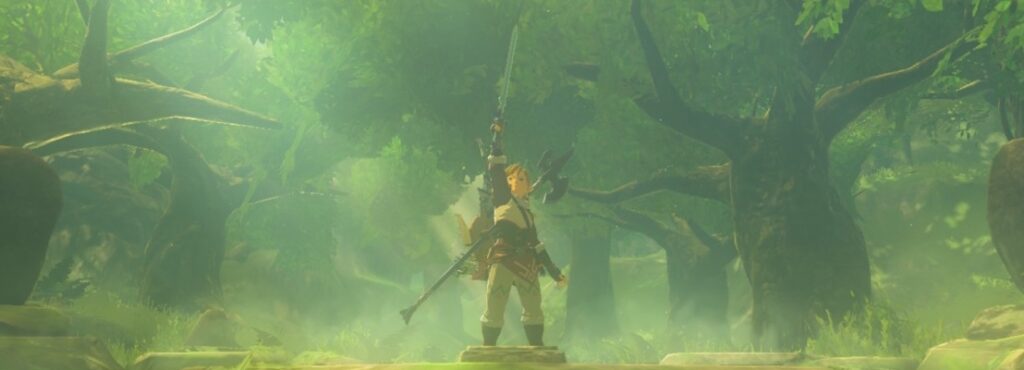
Link as Yamabushi
Link spends a lot of time (assuming one is not speedrunning) climbing mountains and visiting shrines in search of power. Indeed, his visits to the Sheikah monks empower him, granting vitality and endurance.
He interacts with animals and nature in ways few other characters do. Link can feed himself, befriend various animals (and coerce others to do his bidding, such as riding on deer or bears) and arm himself, all from the strength of nature. While he deals greater damage when armed with a proper weapon, it’s entirely possible to beat the game with just a stick.
He possesses unusual powers of observation as well, interacting with spirits and beings who other characters cannot see. Whether it’s the young tree-spirit Hestu, the Koroks, or even the Lord of the Mountain, Link befriends spirits all over Hyrule, and brings benefit to them just like he does for more embodied people.
Let’s compare these activities to a famous description of Buddhist priesthood:
“No sooner does the word go round that you have climbed this or that mountain, than you never get a moment’s peace. All day and night messengers come rushing for you begging you to come at once to houses where there are sick people whom only your spells can cure.”
– The Pillow Book, Sei Shonagon
Link has his own encounters with people pleading for help, although they generally don’t send messengers to find him.
Training the Yamabushi
A closer look at the sources of Link’s training may also be enlightening. The Sheikah monks who grant him pieces of hearts have a historical inspiration as well. Their appearance, with rich jewelry and fairly elaborate clothing, taut blackened skin, and withered limbs, is reminiscent of the Sokushinbutsu (即身仏), monks who sought to become “Buddha in this very body.”
The historical Sokushinbutsu were associated with Shugendo, the syncretic practice of Shinto, Buddhism, and Taoism which also gave rise to the yamabushi (or shugenja).
They mummified themselves before death by practicing a variety of austerities, including drinking tea made from the toxic urushi lacquer tree, and eating only food gathered by themselves in the mountains. Preservation after death was seen as proof of enlightenment, and there are approximately a dozen Sokushinbutsu still enshrined in Japan today.
The historical practice was viewed as a depraved form of suicide and made illegal in the Meiji period, but its imprint remains in many a story. In the case of BOTW, the Sokushinbutsu live on as Sheikah monks. Even their appearances, with large pectoral ornaments and white robes, are similar to the traditional regalia of the yamabushi.

Even in the game terminology, we may see a fusion of Buddhist and Shinto themes. In Japanese, the word used for the shrines, hokora 祠, is specifically a Shinto term referring to a small wayside shrine, often housing a kami who protects travelers from evil spirits. That it houses instead the Sheikah monk, who protects Link once the trial is done, only strengthens the references to Shugendo.
In case there is any remaining doubt that these are holy people, the first four Sheikah monks Link may encounter atop the Great Plateau form the Triforce with their hands: one holds a centered triangle point-downward, while the other three form triangles point-upward, offset to the appropriate spacings for Wisdom, Power, and Courage.
Thus, Link, who already resembles the yamabushi, receives his training from dead mentors whose every detail signals enlightenment lasting past the grave.
Cleansing Nature
Link uses his powers to help the helpless, battle corruption in all its forms, and help nature to regain purity, all of which are appropriate actions for a yamabushi priest to undertake. Link’s battle with the dragon Naydra is a fascinating example.
When Link encounters Naydra frozen in the sacred spring, a battle begins. The dragon has been afflicted with Malice (or “deep-seated grudge,” 怨念 – note the same “grudge” 怨 character as “onryō!”) As Naydra twines around the mountain, Link uses his arrows to strike the Malice from its body, and set it free to resume its role as holy beast, guardian of the mountaintop.

The miko is not the only one who can wield arrows to drive evil away – the yamabushi does just fine, this time in defense of a sacred mountain and its inhabiting spirit.
Finally, Link opposes Ganon in all his forms, as well as challenging his monstrous minions. He cleanses the Malice and finally battles the wicked Triforce wielder himself. The Priest has come all the way to the end of the ghost story. Let’s catch up with the Miko next.
Zelda as Miko
It isn’t just Link who has undergone hardship and strenuous training. Urbosa tells Link some of the tale of Zelda’s struggle to receive divine power during the rule of King Rhoam. She undergoes long hours and physical hardship, and endures the disapproval of her father the King.
“Ever since she was a young girl, she’s gone through rigorous daily routines to show her dedication. She once passed out in the freezing waters trying to access this sealing power.”
– Urbosa, Breath of the Wild
In a striking parallel to Link, Zelda also visits mountains linked to both goddesses and dragons, and prays half-immersed in sacred springs. Her rituals are not just video-game logic exaggerations.

Historically, the itinerant, shamanic miko may have undertaken similar training. Her association with the kami would lead her to seek sacred places, be they springs, mountaintops, or deep forests, much like the yamabushi. She, too, carried signature implements and performed ceremonies of power.
Powers of the Miko
The miko was believed to receive holy powers from her association with the spirit world. She could enter a trance state to summon and communicate with spirits, much as the yamabushi might do through austerities. She could make predictions, determine the causes of sickness, and more. This should sound familiar – the abilities of the yamabushi seem to have been largely derived from the abilities of the shamanic miko.
Even today, miko are associated with bows, typically the “demon-breaking bow” or hamayumi 破魔弓 and “demon-breaking arrow” or hamaya 破魔矢. Many Shinto shrines use a display of archery during Setsubun ceremonies, loosing an arrow as part of a ceremonial banishment of evil spirits.
Hitobashira and Hyrule
Like the yamabushi, a miko in a ghost story may enter a trance to communicate with a ghost. She may attempt to soothe it and permit it to pass on, or she may attempt to exorcise it and deny its power. She may even be sacrificed to appease it, in rare cases.
Here we must add another type to the roster of ghost stories.
There is a historical practice of human sacrifice, usually by burial within a pillar. The sacrifice was not always a miko, but is often a young woman. She would be thrown into a river or buried during the construction of a foundation or pillar. The word “hitobashira” 人柱 literally means “human pillar,” and is idiomatically translated as “human sacrifice.”
While most of the hitobashira verified to exist are in structures relating to water, such as bridges, there are a few in castles as well. The hitobashira may be a mournful ghost, such as the lovely young dancer who, after her interment, shook a castle whenever a young woman danced nearby. She may be angry, and cause flooding with rains that resemble her tears. She may even go willingly, and be granted holy powers as the guardian of a structure.

Princess Zelda, then, may function as a willing hitobashira at the beginning of BOTW.
As we see throughout the memories scattered across Hyrule, after Link’s death in battle with Ganon, Zelda’s power finally ignites. She seals Ganon into Castle Hyrule, but she isn’t able to destroy him by herself.
Instead, she, the miko, must call upon the yamabushi for help.
By the power of sealing herself away with Ganon, she persists as a guardian until her calls reach Link, resurrected by the efforts of their allies. Even then, she acts as a spirit herself – a disembodied voice, so far from her body, sealed into Hyrule Castle.
If Zelda stands in for the miko, and Link stands in for the yamabushi, then the land of Hyrule itself is the sick patient who may only be cured by their divinely granted powers.
The bow was not just used as a weapon, but also plucked like a one-stringed instrument. The miko may dance, play music, or use arrows for blessing, divination, or exorcism, all with the bow as her primary tool.
Looking at Zelda again, there is of course a connection between Princess Zelda and the holy bow – she is the summoner of the Arrows of Light, and may either use them herself, or bestow their power upon Link.
Let’s Talk About the Bad Guy
Ganon doesn’t fit the hungry ghost or penitent spirit, but the onryō as scorned woman doesn’t quite fit either. Looking more closely, there is a subset of onryō tales that refer to the vengeful spirits of nobility: goryō 御霊. “Goryō” is an alternate reading of the more familiar “mitama,” which refers to the spirit of a deceased person. While everyone is considered to have mitama, the title of goryō belongs specifically to wronged nobility.
In goryō tales, the status of the deceased carries over into spiritual power. Driven by hatred and anger, possessing powerful curses, the goryō returns like all onryō for revenge. The stories show such tremendous power that the ghost may blight an entire family or country.
Two goryō are listed among the “Three Great Onryō of Japan:” Sugawara no Michizane, whose wrath at being exiled is said to have caused a plague; and Retired Emperor Sutoku, who was blamed for the rise of the samurai and corresponding upset of the political order of Japan.
That country-ruining power suits what we see of the well-named Calamity Ganon.
Remembering that being a ghost comes with distinct physical traits, let’s examine a passage describing the Retired Emperor.
“In the next instant, a goblin-fire burst from below the Retired Emperor [Sutoku’s] knees, and the mountains and valleys grew as bright as at noontime. Staring at the royal figure in this light, Saigyo saw a face as red as though blood had been poured over it; a tangle of knee-length hair; angry, glaring eyes; and feverish, painful breathing. The robe was brown and hideously stained with soot; the nails on the hands and feet had grown as long as an animal’s claws; he had exactly the aspect of the King of Evil himself, appalling and dreadful.”
– Shiramine, Tales of Moonlight and Rain
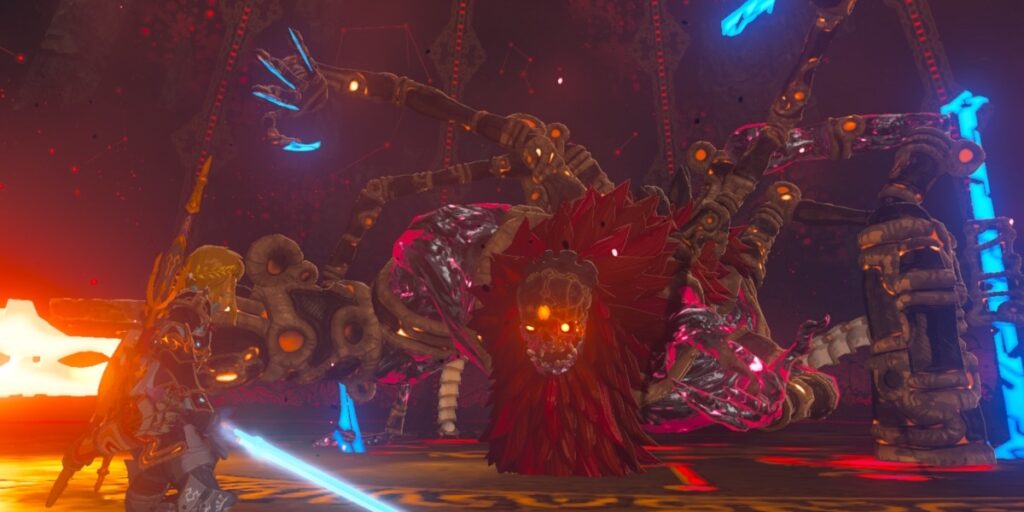
The blood-red face, tangle of unruly hair, glaring eyes, and general uncleanness suit what we see of Ganon. The last thing, then, is to establish his noble credentials, without which he cannot be considered goryō.
Ganondorf, Gerudo Nobleman
Once the foretold child of the Gerudo, once known as the King of Thieves, the wielder of the Triforce of Power, Ganon definitely has claim to not only nobility, but divine power in his own right.
“Ganon was born out of a dark past. He is a pure embodiment of the ancient evil that is reborn time and time again…”
– Princess Zelda, Breath of the Wild
His link to evil is potent, particularly as the source of the corrupting Malice.
“The demon king was born into this kingdom, but his transformation into Malice created the horror you see now.”
Impa, Breath of the Wild
All of his iconography is mixed between evil – malice – and power, natural and unfettered. The admixture makes him a potent, and fascinating, villain. Unlike the other two Triforce wielders, Ganon also has a repeated animal symbol, and its role in Japanese culture is worth examining.
The Boar of Power
Not just a greedy pig, the wild boar or inoshishi is an enduring symbol in Japan.
A protective animal and symbol of untamed – maybe untameable – power, the boar sometimes serves as the mount of gods or buddhas. One famous tale has a wrongfully wounded monk escorted to a temple by a herd of dozens of boars, who heal him with their mighty presence alone before vanishing back into the forest.
Of course, boars are not just a symbol – Japan’s population of wild boars is alive and well, and occasionally there are tales of boars coming into cities, pilfering gardens, and sometimes injuring people. They’re very much wild animals who should be respected, and the strength of the boar is familiar to anyone who has read tales of European knights at their hunts.
In Hyrule, Ganon’s component of the Triforce is understood as the essence of Din, Goddess of Power. As a component of the world and of the repertoire of the hero, it is not only natural, but divine. Ganon misuses it, but Power itself should not be interpreted as harmful.
Instead, it must be tempered with Wisdom and Courage, rather than running as wild as a boar on a rampage. Ganon in his wildness has set Hyrule to ruin, and must be corrected.
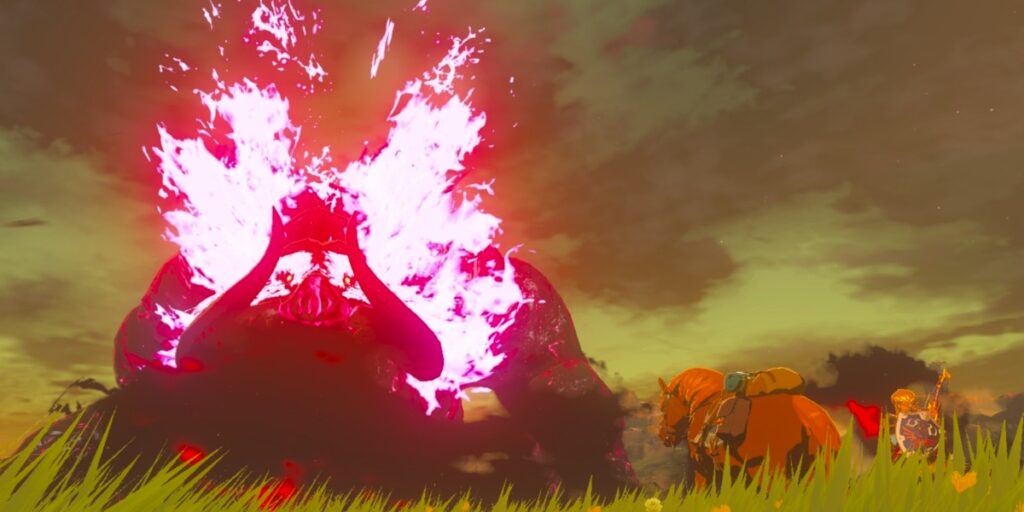
Exorcising the Ghost
The miko gives strength to the yamabushi in the finale of Breath of the Wild, sharing the sacred weapon of the Goddess herself: the demon-breaking Arrows of Light.
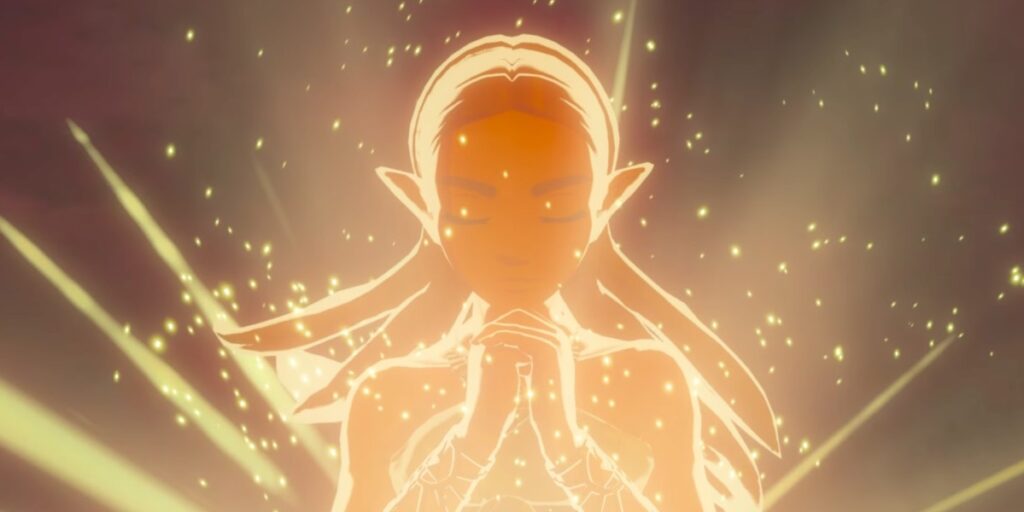
It’s reasonable to ask, seeing the corrupted Divine Beast of Power fade, whether he is possibly gone for good? Of course, with Tears Of The Kingdom reaching release, we know, but even before, the folk tales point to an answer: The goryō is as powerful as its reason for returning. Ganon’s potent malice is enough to bring him back again and again, seeking to unite the Triforce and conquer what he sees as his birthright.
The yamabushi and miko in their ceremonies might transform the harrower into a protective spirit, but the exorcism is incomplete until the ghost’s problem is solved.
I’m excited to see what the Ghost brings us in Tears of the Kingdom.
Sources
On Hungry Ghosts: Excerpt of Gaki-zoshi
On “ascending spirits:” Noh Plays Database: Atsumori
Sacred Arrows
Archer dressed as miko shoots oni target
Shinto priest uses peach-branch bow to purify the four directions
Academic works:
Carmen Blacker The Catalpa Bow (1975)
